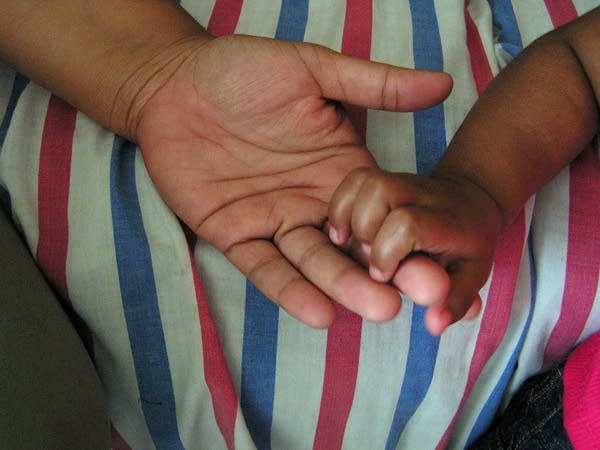Foundation: Child poverty on the rise in Minn.

Child poverty in Minnesota has increased 23 percent in the past decade, according to new figures from the Annie E. Casey Foundation, and advocates say the depth of poverty is increasing as well.
The poverty picture in Minnesota has two faces. Government statistics continue to show that Minnesota's poverty rate is second lowest in the nation behind New Hampshire.
However, the numbers also show Minnesota's child poverty rate has increased by 23 percent from 2000.
Last year the Minnesota Visiting Nurse Agency helped 5,000 children and their mothers living in poverty.
Create a More Connected Minnesota
MPR News is your trusted resource for the news you need. With your support, MPR News brings accessible, courageous journalism and authentic conversation to everyone - free of paywalls and barriers. Your gift makes a difference.
The private, nonprofit MVNA is the public health nursing arm for Hennepin County and the city of Minneapolis. Executive Director Mary Ann Blade, who has worked in public health nursing for four decades is worried about the trend she's seeing.
"For the first time, over 25 percent of our mothers and babies that we see have food scarcity," she said. "Now I have not seen that before."
MVNA public health nurse Nancy Hickerson sees 60-90 babies and mothers a month, about four different visits a day.
Hickerson said poverty remains a trap even with Minnesota's relatively extensive safety net.
Medical care, food stamps and sometimes day care supply an important cushion for many children and mothers living in poverty.
However, Hickerson said housing, transportation, and being able to pay for a phone or an internet connection to look for work all pose problems.
"They tend to deal with crisis after crisis after crisis and can't see themselves outside of that to be able to move forward," Hickerson said.
Nancy Hickerson's weekly visits with 32-year-old Amelia have helped the young mother move out of poverty.
Amelia has asked that her last name not be used. She's sensitive about how others react to her situation.
Amelia got advice from Hickerson on finding a place a live and locating donated furniture.
Hickerson made sure Amelia's 22-month-old daughter who was born premature got health care and follow up visits to avoid more problems.
Unlike most of the mothers Hickerson visits, Amelia has a high school degree and technical training beyond that.
She lost her job and her housing when the recession hit two years ago. Now she's back at work and at a critical point.
Her income may disqualify her for some of the help she is receiving, including day care.
"You make too much, the income guidelines for help, and I don't see where I make too much or how, you know, I can barely make ends meet and they say, 'Sorry, I can't help you, that's too much.'" Amelia said.
The poverty level income for a family of two as defined by the federal government is $14,570. For a family of four the income limit is $22,050.
Those definitions are nearly 50 years old, and advocates regard them as out of date.
There appears to be some movement at the federal level to revise the numbers.
Jim Koppel, the executive director of the Childrens' Defense Fund in Minnesota says poverty these days is different than in the past.
Growing up in a lower-income family in Ohio, Koppel says he witnessed family and neighbors with little more than a high school education, sometimes less, moving out of poverty by landing low- and semi-skilled manufacturing jobs that paid something close to a living wage.
These days, Koppel says, getting out of poverty is a tall order due in part to the education and training needed to land a job.
"We don't have the gradual slope where you can kind of take baby steps into the next economic level," he said. "When you're in poverty you lack essentials, you lack nutrition, you lack transportation, you lack educational opportunities and they are a long way away. They're not just around the corner."
Minnesota's poverty profile is extremely uneven among ethnic groups.
For example, poverty among Asian children living in Minnesota is double the rate of white children, and the poverty rate for African American children is more than four times that of white youngsters.
